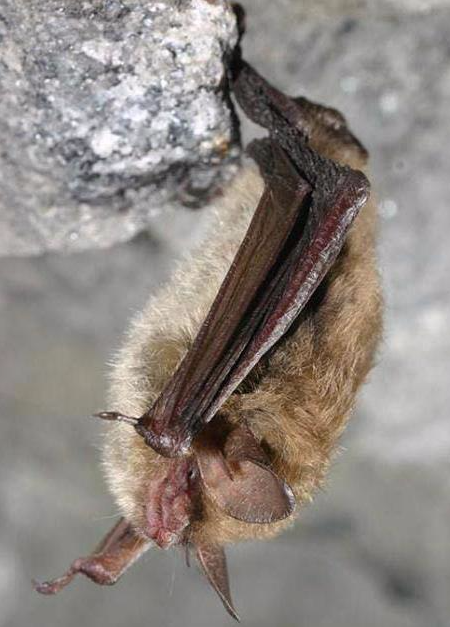Vol. 27, No. 3 ● April 1, 2019
Spring Transitions - Bat Time of Year Restrictions
Hibernating northern long-eared bat. Photo courtesy of Al Hicks, New York DEC
As we transition into warmer weather across Virginia and Maryland, bats in the area are emerging from their winter roosts as they transition to migration and breeding seasons. If your projects involve tree clearing, you may need to follow time of year restrictions for those bat species recognized as threatened or endangered under the Endangered Species Act.
While most bat time of year restrictions begin June 1, the time of year restrictions for the federally-endangered Indiana bat (Myotis sodalis) begin April 1 for activities within 5.5 miles of known bat hibernaculum, and April 15 for areas outside of the 5.5-mile buffer. Both Virginia and Maryland are home to varied species of bats, however the time of year restrictions for tree clearing differ between species and states.
Need Help? Just light the Bat-Signal!
Wetland Studies and Solutions can help you determine if your project is in an area where threatened or endangered bats are known to hibernate or roost, coordinate with Virginia and Maryland agencies, help plan your future projects around bat time of year restrictions, or develop a Conservation Plan – we can also perform a bat survey on your project site if required. For more information about any of our bat services, contact Ben Rosner or Mark Headly for projects in Virginia or Mike Klebasko for Maryland projects.
More About Bat Time of Year Restrictions (TOYR)
Indiana Bat TOYR
click to enlarge
As a federally-endangered species, the Indiana bat is afforded greater protection than other federally-threatened or even state-endangered species – so tree clearing near known hibernaculum or roosts is restricted for a longer period. In Virginia and Maryland, the time of year restriction for the Indiana bat runs from April 1 to November 15 for activities within the 5.5-mile hibernaculum buffer, and April 15 to September 15 for areas outside of the 5.5-mile hibernaculum buffer.
If your project is within a county where the Indiana bat is known to hibernate or roost (see map), you must coordinate with the U.S. Fish and Wildlife Service (USFWS) prior to clearing trees during any time of year.
Northern Long-Eared Bat TOYR
Both Virginia and Maryland are home to the northern long-eared bat (Myotis septentrionalis), a federally-threatened species under the Endangered Species Act. In Virginia, the Virginia Department of Game and Inland Fisheries website identifies the approximate location of known hibernacula and known maternity roost trees for the northern long-eared bat. In Maryland, you must coordinate with the USFWS Chesapeake Field Office for any tree clearing in Allegany, Garrett, and Washington Counties.
The final 4(d) rule for this species allows incidental take throughout most of Virginia and Maryland, but prohibits tree clearing within 150 feet of known occupied maternity roosts from June 1 through July 31.
Tree clearing is prohibited:
Within 0.25 miles of known hibernacula, at any time of year.
Within 150 feet of known occupied maternity roosts, from June 1 to July 31.
Tree clearing is allowed:
Further than 0.25 miles from known hibernacula, at any time of year.
Further than 150 feet from known occupied maternity roosts, at any time of year.
Within 150 feet of known occupied maternity roosts, from August 1 to May 31 (USFWS coordination required).
To remove hazard trees to protect human life and property, at any time of year.
Little Brown Bat and Tri-Colored Bat TOYR
Both the little brown bat (Myotis lucifugus) and tri-colored bat (Perimyotis subflavus) are state-endangered in Virginia, with tree clearing restricted from June 1 through July 31. The Virginia Department of Game and Inland Fisheries website identifies the approximate location of known hibernacula and known maternity roost trees for the little brown bat and tri-colored bat. Neither species is state-endangered or subject to time of year restrictions in Maryland.
Tree clearing is prohibited:
Within 0.25 miles of known hibernacula, at any time of year.
Within 150 feet of known occupied maternity roosts, from June 1 to July 31.
Tree clearing is allowed:
Further than 0.25 miles from known hibernacula, at any time of year.
Further than 150 feet from known occupied maternity roosts, at any time of year.
Within 150 feet of known occupied maternity roosts, from August 1 to May 31 (no coordination required).
To protect human life and property by removing hazard trees, at any time of year.


